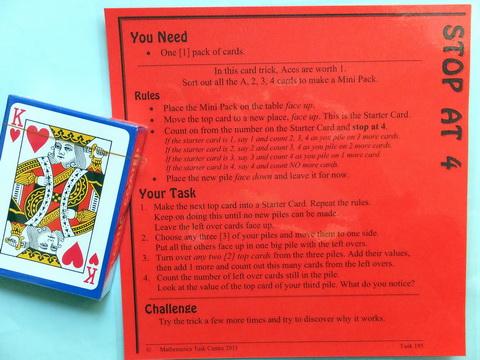
Stop At 4Task 195 ... Years 4 - 8SummaryAll the challenge on the card refers to this task as a trick it really isn't. It is an ingenious use of cards to produce a situation where the number of cards left in a pile gives the number on a particular card. The rules are enough to make you lose track of what each step does, so mathematics is needed to bring clarity to the analysis. However, before the analysis begins the students will need to do enough trials to discover that the last always produces the same number in two different ways.This cameo includes two Investigation Guides. |
Materials
Content
|

IcebergA task is the tip of a learning iceberg. There is always more to a task than is recorded on the card. |
Step 4 on the card asks: What do you notice?. It might take a couple of times playing to realise, but what should be noticed is that the number of cards remaining in the left over pile is 'predicted' by the top card turned over in the last of the three piles that have been put aside. (You really have to work this task through yourself to experience the surprise involved in that 'prediction'.) The challenge is to work out how the 'trick' is structured and that investigation may require a little assistance.The questions below will help. However, try to avoid spoiling it for the students by revealing the answers too soon.
Imagine the starter card represents that number of invisible cards. We say the value of the starter and count on until we stop at 4. Looking at it this way we see:
( ) = the starter card itself; its value counts the invisible cards © = a card you place as you count on to 4. So, the sum of invisible and counting on cards is 4 each time and the starter card itself - the brackets - are counted as one more. Now we can ask questions about the rest of the task.
Extensions
Stop at 4 was contributed to the task collection by Ian Lowe, mathematics consultant, who also contributed the guide and answers. The guide was originally printed in the Lower Secondary Computation Replacement Unit of the Mathematics Task Centre Project. A Replacement Unit is one form of unit plan. It integrates the use of both the invitation and the whole class lesson lives of a task. |
Whole Class InvestigationTasks are an invitation for two students to work like a mathematician. Tasks can also be modified to become whole class investigations which model how a mathematician works. |
Assuming you have sufficient packs of cards, this is an excellent investigation for illustrating how mathematical reasoning, supported by symbolic representation can make sense of situation. One way to begin the lesson is to become skilful yourself at presenting say the 1 - 4 game as a 'trick' at a central table. Start with a statement like: Today I'm going to show you a magic trick before we start our mathematics. I'll need a helper. How about you Maria. Thanks, you can shuffle that pack if you want to. Now I'm going to give Maria instructions that will mess the pack up and even split it into parts, but in the end I will be able to amaze you with something I know about what's in her hand.Play the trick through, finishing up with an 'amazing' statement like: Now Maria this card I didn't turn over before will count the number of cards remaining in your hand.Try the same trick with another student just to show it isn't an accident. Would you like to learn how to do this trick?Ask the students to retell the steps you used and note them on the board as they are agreed. Hand out the card packs and let the students practice. When they are confident they can make the trick work, you can set the challenge of finding out how it works. A mathematician might ask why this trick always works. Next time you play, try to focus on how numbers are being used. If you notice anything let me know so we can discuss it.Guide the class along using the questions and analysis above. The aim is to be able to describe how using the mathematical symbols clarifies the mystery and why the physical actions such as face up, face down and separating into piles are included in the presentation. These actions are part of the theatre surrounding the 'magic' as well as part of the mathematical analysis. The conclusion of the lesson could be either that the students have to prepare an explanation in some form for others to understand, or that they test their new found analysis skills using one, or more, of the questions from Investigation Guide A above. At this stage, Stop At 4 does not have a matching lesson on Maths300. |
Is it in Maths With Attitude?Maths With Attitude is a set of hands-on learning kits available from Years 3-10 which structure the use of tasks and whole class investigations into a week by week planner. |
Stop At 4 is not in any MWA kit. However it can be used to enrich the Number & Computation kit at Years 7 & 8. |